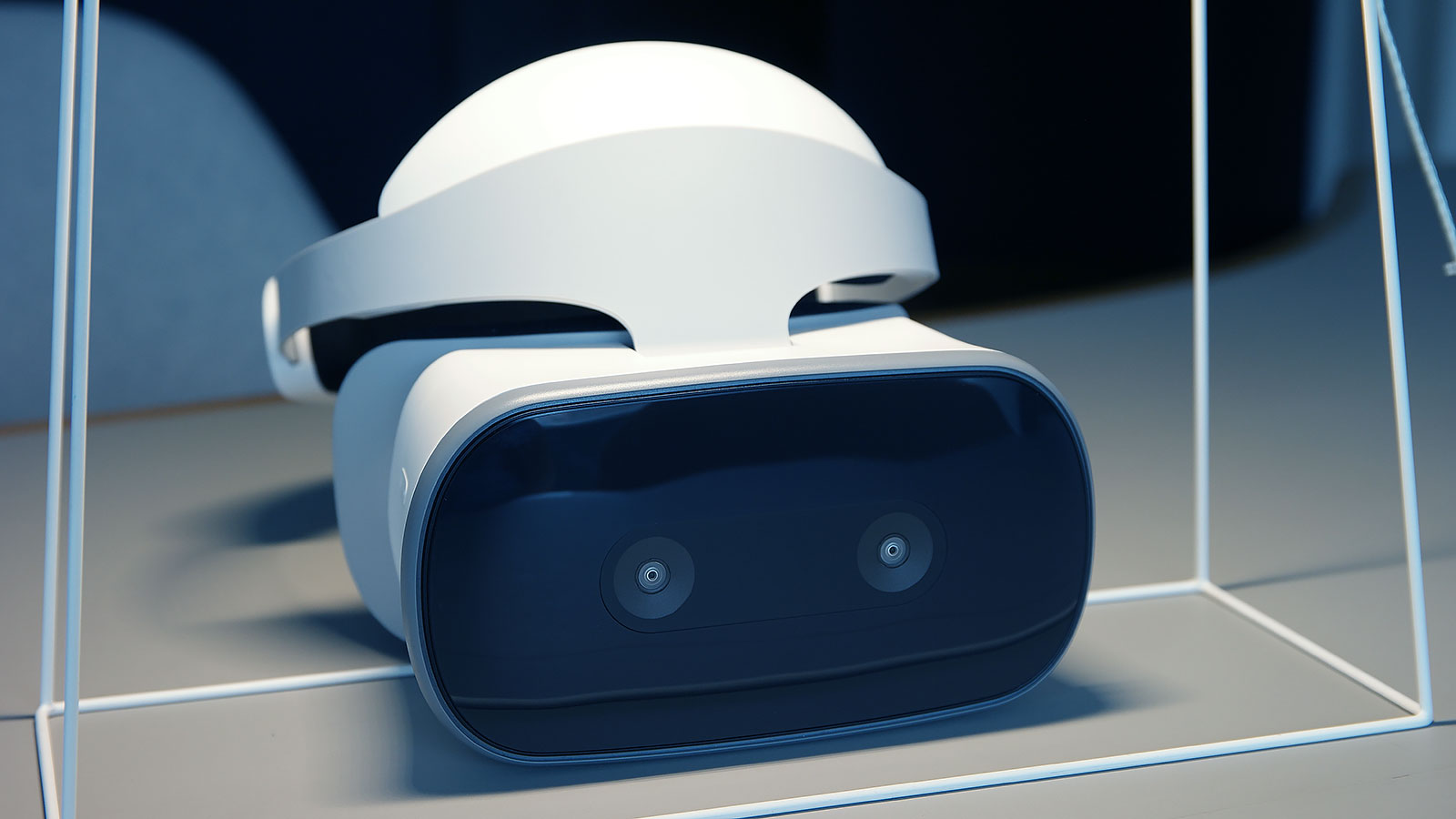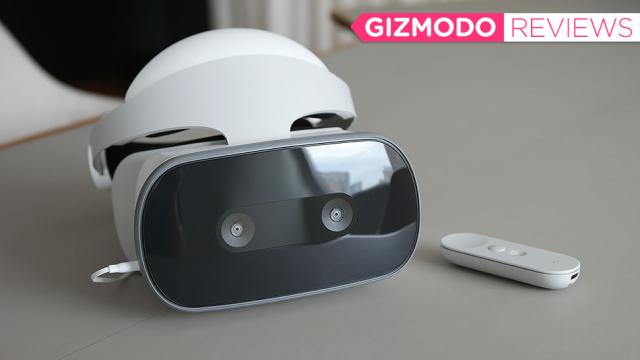Photo: Sam Rutherford (Gizmodo)
Only a couple of weeks since the first standalone VR headset was released, and already we have another. Except this one is made by Lenovo in partnership with Google and uses the Daydream VR platform. Like the Oculus Go, Lenovo’s Mirage Solo don’t need no phone or a wire connected to a nearby PC to transport you to other worlds. Everything you need comes built into the goggles.
But Lenovo didn’t stop there because in addition to having a highest resolution display, the Mirage Solo supports Google’s WorldSense tech, so you can bob-and-weave through VR at speed, without a hint of lag, something that’s much more difficult for the Oculus Go to do.
And then, Lenovo even went and made a dedicated VR camera to help people create VR-ready content more easily. All together, this is a big play to make new kind of VR stand out, so did it actually work?
To make WorldSense a possibility, Lenovo put two front-facing cameras on the outside, which the headset uses to track movements in six different directions without needing external cameras or lighthouses more expensive PC-based HMDs require.
And then on the inside, the Mirage Solo sports a Qualcomm Snapdragon 835 processor, a full generation newer than the Snapdragon 821 chip in the Oculus Go, along with 4GB of RAM, and 64GB of storage. This gives the Mirage Solo’s a slight edge over the Oculus Go in the specs department, something that becomes immediately apparent as soon as you put on the headset.
That’s because with that extra horsepower, the Mirage Solo does a fantastic job of delivering high-resolution, low latency visuals. That last part is super important, as quite frequently, the delay between when you move your head and when the headset’s graphics actually respond is what causes VR motion sickness. Too slow and you want to vomit.
The motion tracking feels quite accurate too, and thanks to those cameras on the outside, the headset can even warn you if you move your head too much and are at risk of bumping into something in meatspace.
But what may have been the biggest shock for me, is the Mirage Solo’s battery life. On its site, Lenovo claims a runtime of 2.5 hours between charges, but even with me downloading apps in the background and playing a variety of games back-to-back, I found the Mirage Solo’s battery life was closer to three and a half hours or even four depending on the usage.
So the Mirage’s optics are great, it has more horsepower than the Oculus Go, and it has the kind of longevity that means your body is going to call it quits before it runs out of juice. Not a bad start.
Sadly, things started going downhill after that, because the more time I spent using the Mirage Solo, the less I liked it. The first issue is this thing’s comfort. With all of the headset’s guts and components stuffed up front, it’s not balanced at all.
Lenovo attempts to mitigate that by building an easy-to-use adjustment dial into the the device’s headband. However, without a strap going over the top, the headset often felt like it was either trying to crush my nose, or jammed painfully into my forehead while leaving an annoying gap that let light from the outside ruin my VR experience.
The padding around the face mask is also too thin, and despite weighing four ounces less than a Vive Pro, the Mirage Solo is much less comfortable to wear. There’s also a lack of proper ventilation , which means you get VR sweats. Not a good look.
However, the biggest problem with the Mirage Solos isn’t the headset, it’s the platform and ecosystem behind it. Even with over 250 apps available on Daydream VR, there simply aren’t that many that can actually hold my attention for more than 10 minutes.
Stuff like Google’s Back to the Moon Spotlight Story is cute, but it’s over in less than 180 seconds, which means just as soon as you think you’ve found something to hold you down, you’re on the hunt again.
And I don’t know about you, but I can only play so many shooting galleries before my enthusiasm for VR starts to wane. Most of the good apps like Keep Talking and Nobody Explodes have been available on other VR platforms for quite a while, so it’s hard to get super excited about those either. Often times the Daydream VR’s shallow app selection feels like a reminder of how much I like Rez Infinite. But there’s only so many times I can play the same game before it gets boring too.
Trying to discover new games to play is tedious too. In the Daydream VR Play Store, there isn’t even a search function, which feels like a cardinal sin for something made by Google. That means you have to slowly scroll through long lists of apps, six at time, hoping that something catches your eye.
There’s barely any curation, with apps and experiences split between a handful of generic categories such as “Casual Fun” and “Learn and Explore.” Where are the AI-powered recommendations or Google Assistant integration so I can simply speak the name of an app and let the device do the rest? It seems like Daydream is the project that Google forgot about when it was giving everything else it makes machine learning abilities.
I turned to streaming video and browsing through photos in VR to fill my time. YouTube in virtual reality is actually kind of nice, and I developed a bad habit of putting on the headset, laying down, and looking towards the ceiling while watching random shows. It’s really quite relaxing, but in the back of my head, I know its a silly way to use an HMD.
So to help make even more content for people to consumer in VR, Lenovo also created a companion device in the Mirage Camera. It can be used to capture stereoscopic pictures and videos that looks good in a headset.
It’s super streamlined (there’s only three buttons on the entire device) and it should give people an easy way to produce more VR-friendly content. But once again, there’s the price to consider, because the Mirage Camera costs $US300, which brings the total cost up to $US700 (sorry all, no Australian price or release date yet).
So now, what was supposed to be an accessible way to introduce more people to VR has gotten much less approachable.

There’s still too much junk like this on the Daydream store. GIF: Sam Rutherford (Gizmodo)
Currently, the problem for VR is two fold. Yes, people are looking for simple, and the Mirage Solo certainly delivers on that front. It’s easy to use, sometimes even to its own detriment.
But the other quality people are looking for is affordable, and at $US400, the same price as a full blown Oculus Rift and twice the price of an Oculus Go, the Mirage Solo is just too damn expensive. Particularly when you consider the content options.
Games like Rez Infinite, Keep Talking, and Nobody Explodes are fantastic experiences, but neither are unique to the Mirage Solo or, for that matter, the Daydream platform. And even though I like watching YouTube in VR, it’s incredibly hard to justify shelling out $US400 for that luxury.
That leaves the Mirage Solo stuck between an Oculus Go and a HTC Vive, with neither the price tag to compete on the low end, or the app library and features to battle it out with premium PC-based HMDs.
And until Daydream VR matures and makes the platform more enticing, that’s a really awkward place to be. I really wish this thing was cheaper, because standalone VR headset was supposed to be the dream. But the Mirage Solo isn’t quite there yet.

Photo: Sam Rutherford (Gizmodo)
README
- The headset is so front heavy that despite weighing less than a Vive Pro, it’s not nearly as comfortable. And it gets sweatier too.
- Battery life is pretty decent, lasting between 3 and a half and four hours or more depending on what you’re doing.
- The Mirage Solo’s included controller is the same as the one you get with the original Daydream View, which is mostly fine, but occasionally has issues with wonky touchpad sensitivity.
- Potentially the biggest issue with the Mirage Solo isn’t the hardware, it’s the Daydream platform itself, which still feels pretty barren and compared to other VR headsets.
- The Mirage Solo costs $US400 ($536) which is twice the price of the Oculus Go. Ouch.
SPECS
Qualcomm Snapdragon 835 processor • Daydream 2.0 • 4GB of RAM • 64GB of storage • 2560 x 1440 5.5-inch LCD Display (1280 x 1440 to each eye) • 75 Hz refresh rate • 110-degree FOV • microSD card slot • headphone jack • USB-C port • dual six-degrees-of-freedom tracking cameras • included Daydream controller • 4,000 mAh battery • weighs 771.1g
